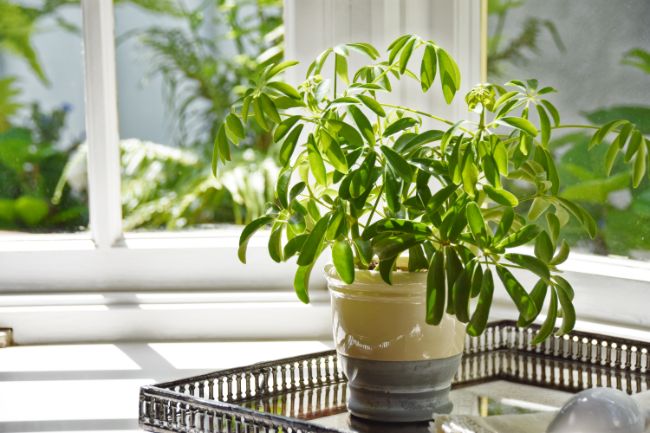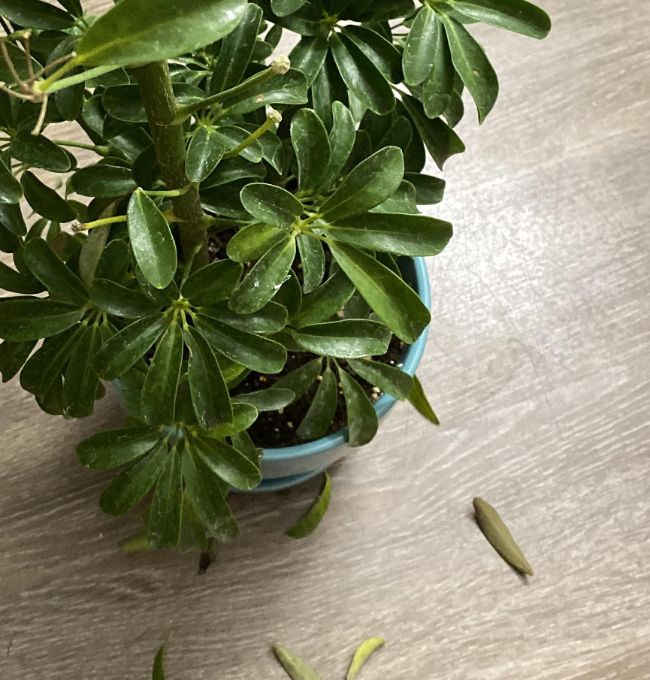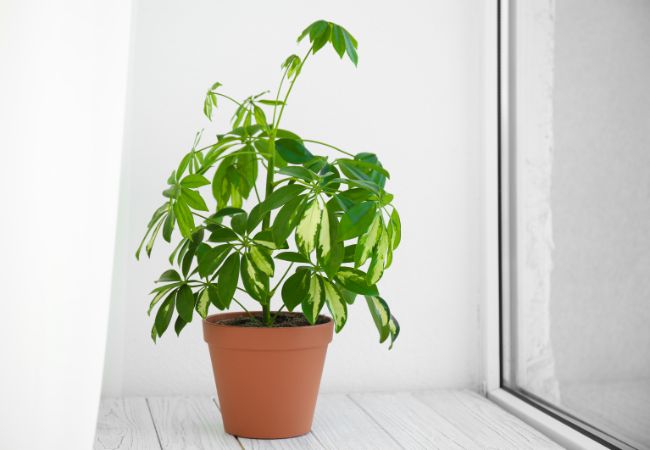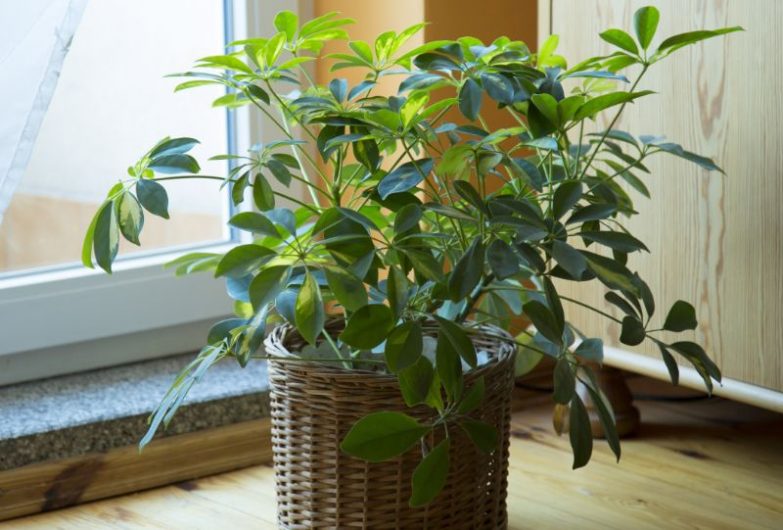Scheffleras, or Umbrella Plants, are a great choice for bringing bold, tropical green foliage indoors. These robust plants can withstand some neglect, but it’s not uncommon for them to shed leaves in reaction to stress. Let’s take a look at why your Umbrella Plant might be dropping leaves and how to get it back on track.
An Umbrella Plant dropping leaves is normally a sign of stress due to improper care. Over or underwatering, low light, temperature extremes, repotting, pests, diseases, under/overfeeding, low humidity, or a new location can cause dropping leaves. Old leaves will also drop naturally.
Overview: Umbrella Plants (Schefflera Arboricola) And Leaf Loss
Schefflera Arboricola, or the Dwarf Umbrella Plant, is a warm-climate shrub that’s become popular as a hardy evergreen houseplant. This fast-growing tropical can grow to the ceiling, but it can also be pruned to stay compact. They like bright indirect light and moist soil but tolerate a range of conditions.
The Arboricola is a dwarf version of the even faster-growing Actinophylla. Besides the all-green standard types, there are varieties with white or gold variegation.
It’s natural for the Umbrella Plant to drop occasional leaves, but active shedding usually indicates sub-par growing conditions or caretaking mistakes. Correcting these factors typically stops leaf loss; the plant can quickly grow new foliage if they receive proper care.
Usually, the bottom leaves are affected most. Be aware that dropped leaves don’t typically grow back in the same place and can give the plant an “umbrella” look before its time. If you want a bushier style, address leaf loss early.
Light Issues
Scheffleras prefer bright indirect lighting. Not only can they drop leaves in low-light conditions, but the growth will become leggy and spindly. If your variegated specimen is losing its color and becoming uniformly green, it’s a sign that it needs more light.
Indoors, a bright natural exposure is suitable if you give the plant protection against intense direct rays. Morning or late afternoon sunlight is usually fine. If you see scorching on leaves, move the plant a few feet from the window or increase its protection. The plant does well outdoors with midday shade.
A Schefflera can tolerate lower light, but stay alert. The plant can struggle with insufficient lighting for some time before suddenly beginning to shower leaves. If you’re not seeing healthy new growth, consider upping their light to head off potential problems.

Watering Problems Are The Most Common Reason For Leaf Loss
Either overwatering or underwatering can stress the plant enough to trigger leaf loss, but you have to be careful to diagnose the problem correctly. Scheffleras prefer a moist medium but deal with drought conditions much better than sodden soil.
The general rule is to water your Schefflera when the top inch of soil dries out. Water thoroughly and let the excess drain through the holes to flush the soil.
One sign of overwatering trouble is if the leaves turn black before dropping off. If this happens, unpot the plant and inspect the soil for mushy, foul-smelling roots. Root rot is deadly and the upper parts of the plant may not show symptoms until it’s too late.
Cut back on watering during the cool season. The plant should only be given enough water to avoid drying out. Also, make sure the water is room temperature: their roots can be shocked by cold water.
Though a Schefflera is more forgiving of dry soil than a soggy pot, it isn’t a cactus. Underwatering can stress the plant, too. Also remember that bone-dry soil doesn’t absorb water as easily. After a prolonged drought, always soak the plant carefully. Insert a wooden chopstick or such tool into the soil to confirm the entire media has been moistened.
Read more about how to tell when houseplants need watered, and how often to water houseplants for more info.
Heavy Soil
Compact soil is an indirect cause of stress and a contributing factor to leaf shedding. The ideal media is well-draining and has enough aeration to preserve oxygen around the roots even immediately after watering.
A quality potting mix is usually acceptable, but consider combining it with cactus soil or improving the aeration with perlite or coarse sand.
Two factors can affect your Schefflera’s soil over time:
- Peat provides moisture retention, but it eventually decomposes into smaller particles that can make the soil too dense. Bark, compost and other organics do the same.
- Salts and other toxins from fertilizer and highly mineralized tapwater can build up in the soil and affect roots, especially if the drainage is insufficient. Avoid partial watering—always let the water drain freely from the pot to wash away any buildup. Give the soil a heavy watering every month or two in the growing season to keep it flushed and fresh.
Read my guide to making and choosing soil for your houseplants to learn more.
Cold Temperatures
Scheffleras are tropical plants which originated in climates that seldom fall below 50ºF ( 10ºC). Cold stress can make them drop leaves. All-green varieties generally have a little more cold tolerance than variegated cultivars.
Otherwise, Umbrella Plants enjoy a generous range of indoor temperatures and thrive between 60º (16º) and 80ºF (27ºC). Be careful to protect them from low temps if they’re kept near a window. The plant can be grown outdoors year-round in USDA Zones 9b-12.
Drafts
Like most houseplants, Scheffleras are averse to drafts. Either a hot or cold stream can trigger leaf loss. If your plant is in the path of an air current, give it protection or relocate the pot.

Fertilization Mistakes
Umbrella Plants are not heavy feeders. Overfertilization can shock their system and cause dropping leaves. If you suspect overfeeding, flush the soil to help remove the excess.
You might see leaf drop if the plant is severely undernourished, too. An underfed specimen should have other symptoms, though: its new foliage will likely be minimal, pale, and/or undersized.
If the plant is healthy, a Schefflera responds to light feeding in the growing season. A half-diluted dose of a balanced fertilizer once a month helps fuel their growth. Stop feeding in late fall and through the winter.
Acclimation
Changing a Schefflera’s environment often causes temporary leaf loss. This is common with new purchases or when bringing a summering plant indoors.
To minimize the issue, try to match the light your Schefflera received before the move. A specimen coming inside for the winter should be put in the brightest spot you have. With proper care, the plant will soon recover … and its new foliage will be adapted to the new location.
Humidity
Scheffleras are fairly tolerant of the dry air in our homes. Low humidity isn’t optimal, but it’s more a contributing stress factor to leaf drop instead of its primary cause.
Your plant won’t complain if you raise their humidity, however, and it can increase their resiliency. Humidifiers work great, but you can modestly improve air moisture by putting water trays near the plant. Placing a water-filled saucer filled with pebbles underneath a pot is a common solution.
Grouping with other plants also provides a slight humidity boost. Some growers mist their plants, but it’s not an effective way to raise humidity. Read more about how to effectively raise humidity for your houseplants in this article.
Stress Due To Repotting Can Cause Your Umbrella Plant To Lose Leaves
Scheffleras are likely to shed at least a few leaves after repotting. It’s a little traumatic for them (much more than pruning). The plant doesn’t mind being mildly rootbound and generally only needs repotting every two or three years.
Conversely, severely rootbound Scheffleras may drop leaves if the pot is too small; a constricted root system supports only so much foliage. Scheffleras can do well in a relatively small container … just make sure it’s heavy enough to counterbalance their top-heavy canopy.
Other repotting tips:
- If you need to water more than twice weekly, it’s time to repot.
- Don’t fertilize for several weeks after repotting so the fresh, tender roots aren’t burned. Fresh soil usually has sufficient nutrition.
- A Schefflera’s roots can emerge from the soil as they grow … don’t add new soil over them. It can smother the plant.
- Repot early in the growing season to give the plant time to recover.
- It’s tempting to repot a plant you’ve just brought home, but it’s better to let them acclimate to their new location first.

Infestations
We aren’t the only ones who like an Umbrella Plant’s foliage. The plant has some resistance to pests, but an infestation can weaken the plant and result in your umbrella plant dropping leaves
Typical juice-sucking insects can be a problem, but the most common invader is spider mites. They like dry conditions and can quickly colonize a struggling Schefflera.
Cleaning the leaves is a good proactive measure. Pay special attention to the undersides where pests like to hang out. If you see an infestation, repeated treatments with horticultural oils and insecticidal soaps can bring them under control. Read more about how to identify, treat and prevent common houseplant pests here.
Fungal issues and leaf blight can cause leaf problems: misting may actually promote the environment they thrive in. Prune infected leaves for safe disposal.
Dropping Leaves Can Be Normal
An umbrella plant with dropping leaves may be entirely healthy, as old foliage naturally drops off as the plant grows. Typically the tips and edges discolor until the whole leaf turns yellow. You can slow the progression with optimal care, but occasional loss from age is inevitable.

